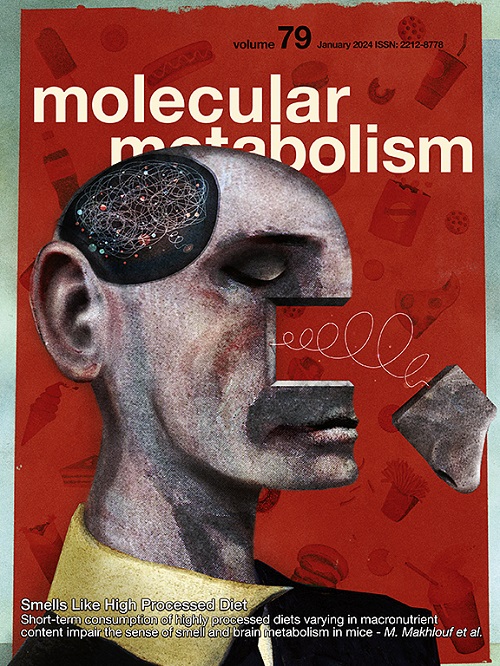Diverse actions of 15 structurally unrelated mitochondrial uncouplers in cells and mice
IF 7
2区 医学
Q1 ENDOCRINOLOGY & METABOLISM
引用次数: 0
Abstract
Objective
Mitochondrial uncouplers are used as chemical tools to study mitochondrial function in vitro and in vivo, and some molecules are in development for the treatment of metabolic diseases. One problem in the field is that any molecule that increases proton transport into the mitochondrial matrix independent of ATP production can be classified as an uncoupler regardless of off-target activities. Therefore, there are dozens of classes of molecules that exhibit a wide spectrum of phenotypes. Herein we directly compared 15 mitochondrial uncouplers side-by-side in a well-defined cell system to better understand their in vitro dose response profiles and the top molecules with suitable pharmacology and safety profiles were compared in db/db mice.
Methods
Fifteen mitochondrial uncouplers were characterised in vitro in CHO–K1 cells. The top five candidates were selected for further characterisation in male db/db mice based on their in vitro dose response and/or tolerability. We tested two doses of each mitochondrial uncoupler in mice and benchmarked their efficacy to a lifestyle intervention of 35% calorie restriction as well as to lean db/+ metabolically healthy mice. Eleven groups of mice were fed ad libitum either; 1) chow (control), 2) chow with 0.15% BAM15 (w/w), 3) chow with 0.2% BAM15 (w/w), 4) chow with 0.1% NEN (w/w), 5) chow with 0.25% NEN (w/w), 6) chow with 0.01% OPC-163493 (w/w), 7) chow with 0.02% OPC-63493 (w/w), 8) chow with 0.015% ES9 (w/w), 9) chow with 0.03% ES9 (w/w), 10) chow with 0.2% NTZ (w/w), and 11) chow with 0.4% NTZ (w/w). Another group of mice was fed chow to receive ∼65% of the average daily food intake of control mice as a model of calorie restriction (CR). Mice were metabolically phenotyped over 4 weeks of treatment with assessment of key readouts including body weight, HbA1c, blood glucose and glucose tolerance tests. At termination, key tissues were collected and plasma was analysed for markers of toxicity.
Results
Few mitochondrial uncouplers behaved similarly in vitro, with 11 molecules impairing maximal mitochondrial capacity. In vivo, BAM15 dose-dependently improved body weight and metabolic parameters in db/db mice, with 0.2% BAM15 treatment yielding statistically significant improvements in body weight, fat pad weight, glucose tolerance, blood glucose, HbA1c, liver weight and triglyceride content. The next-best treatment was 0.03% ES9 which significantly improved glucose tolerance, blood glucose levels, and HbA1c, but increased body weight, liver size and steatosis relative to db/db controls.
Conclusions
Mitochondrial uncouplers BAM15 and ES9 had the greatest dose tolerance range in vitro, while BAM15 had the best overall effects on body weight, glucose control and liver steatosis in db/db mice. This study reveals diverse phenotypes across 15 classes of mitochondrial uncouplers and underscores the need for rigorous evaluation to identify molecules that drive stable mitochondrial respiration without unwanted mitochondrial inhibition or off-target effects. Ultimately, mitochondrial uncouplers should not be generalized and each uncoupler molecule needs to be considered by its own actions in well-defined experimental conditions.
15种结构无关的线粒体解偶联剂在细胞和小鼠中的不同作用。
目的:线粒体解偶联剂是研究线粒体体外和体内功能的化学工具,一些分子正在开发用于治疗代谢性疾病。该领域的一个问题是,任何独立于ATP产生而增加质子进入线粒体基质的分子都可以被归类为解偶联剂,而不管脱靶活性如何。因此,有几十类分子表现出广泛的表型。在此,我们直接比较了15种线粒体解偶联剂在一个明确定义的细胞系统中的并排,以更好地了解它们的体外剂量反应谱,并在db/db小鼠中比较了具有合适药理学和安全性谱的顶级分子。方法:在CHO-K1细胞中对15种线粒体解偶联剂进行体外鉴定。根据其体外剂量耐受性和/或耐受性,选择前5个候选物在雄性db/db小鼠中进行进一步表征。我们在小鼠身上测试了每种线粒体解耦剂的两种剂量,并将其功效与35%卡路里限制的生活方式干预以及瘦db/+代谢健康小鼠进行了基准测试。11组小鼠分别被喂食;1)自由放养-鼠(对照),2)0.15% BAM15 (w/w)鼠,3)0.2% BAM15 (w/w)鼠,4)0.1% NEN (w/w)鼠,5)0.25% NEN (w/w)鼠,6)0.01% OPC-163493 (w/w)鼠,7)0.02% OPC-63493 (w/w)鼠,8)0.015% ES9 (w/w)鼠,9)0.03% ES9 (w/w)鼠,10)0.2% NTZ (w/w)鼠,11)0.4% NTZ (w/w)鼠另一组小鼠以对照组小鼠平均每日食物摄入量的~ 65%作为卡路里限制(CR)模型。在4周的治疗期间,对小鼠进行代谢表型分析,评估关键读数,包括体重、糖化血红蛋白、血糖和葡萄糖耐量试验。终止时,收集关键组织并分析血浆中毒性标志物。结果:少数线粒体解偶联剂在体外表现相似,有11个分子损害最大线粒体容量。在体内,BAM15剂量依赖性地改善了db/db小鼠的体重和代谢参数,0.2% BAM15处理对体重、脂肪垫重量、葡萄糖耐量、血糖、HbA1c、肝脏重量和甘油三酯含量的改善具有统计学意义。次佳治疗是0.03% ES9,显著改善了葡萄糖耐量、血糖水平和HbA1c,但相对于db/db对照组增加了体重、肝脏大小和脂肪变性。结论:线粒体解偶联剂BAM15和ES9的体外剂量耐受性范围最大,而BAM15对db/db小鼠的体重、血糖控制和肝脏脂肪变性的综合效果最好。这项研究揭示了15类线粒体解偶联剂的不同表型,并强调需要进行严格的评估,以确定驱动稳定线粒体呼吸的分子,而不会产生不必要的线粒体抑制或脱靶效应。最终,线粒体解偶联剂不应该一概而论,每个解偶联剂分子都需要在明确的实验条件下通过其自身的作用来考虑。
本文章由计算机程序翻译,如有差异,请以英文原文为准。
求助全文
约1分钟内获得全文
求助全文
来源期刊

Molecular Metabolism
ENDOCRINOLOGY & METABOLISM-
CiteScore
14.50
自引率
2.50%
发文量
219
审稿时长
43 days
期刊介绍:
Molecular Metabolism is a leading journal dedicated to sharing groundbreaking discoveries in the field of energy homeostasis and the underlying factors of metabolic disorders. These disorders include obesity, diabetes, cardiovascular disease, and cancer. Our journal focuses on publishing research driven by hypotheses and conducted to the highest standards, aiming to provide a mechanistic understanding of energy homeostasis-related behavior, physiology, and dysfunction.
We promote interdisciplinary science, covering a broad range of approaches from molecules to humans throughout the lifespan. Our goal is to contribute to transformative research in metabolism, which has the potential to revolutionize the field. By enabling progress in the prognosis, prevention, and ultimately the cure of metabolic disorders and their long-term complications, our journal seeks to better the future of health and well-being.
 求助内容:
求助内容: 应助结果提醒方式:
应助结果提醒方式:


